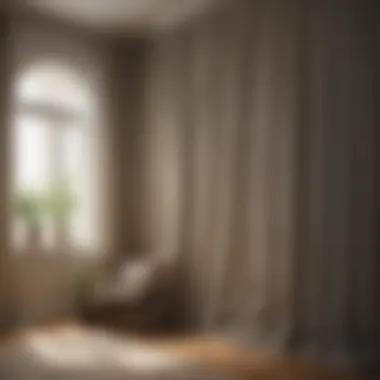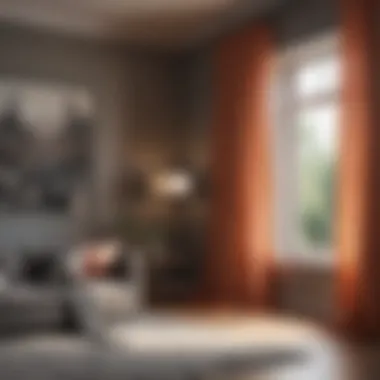Mastering the Art of Calculating Curtain Width for Perfect Home Interiors


Interior Design Tips
Trendy Design Ideas
Stay ahead of the curve in interior design by considering the latest trends when determining the width of your curtains. Opt for sleek, floor-to-ceiling drapes for a luxurious and contemporary feel, or experiment with bold patterns and textures to make a statement in your living room or bedroom.
Color Schemes and Combinations
Harmonizing curtain colors with your existing decor palette is essential for a cohesive look. Consider the mood you want to evoke - from tranquil blues to vibrant reds, the right color scheme can transform your space. Remember to factor in natural light and room size when choosing curtain colors to create the illusion of space and light.
Furniture Arrangement Techniques
When calculating curtain width, it's crucial to take into account your furniture layout. Ensure that your curtains do not obstruct furniture or windows when drawn. In open-concept spaces, use curtains to delineate zones and create a sense of separation while maintaining an open feel. Experiment with different curtain lengths and styles to complement your furniture arrangement seamlessly.
Understanding the Importance of Curtain Width
Curtain width plays a crucial role in home interiors, impacting both aesthetics and functionality. A well-chosen curtain width can significantly enhance the visual appeal of a room while providing practical benefits. When considering curtain width, factors such as creating visual appeal, influencing light levels, and enhancing room proportions come into play.
Impact of Curtain Width on Room Aesthetics
Creating Visual Appeal
Creating visual appeal through curtain width involves choosing the right width to complement the room's overall design. Opting for wider curtains can make a room feel more spacious and grand, while narrow curtains can create a cozy and intimate atmosphere. The choice of curtain width impacts the perceived size of windows and can transform the overall look and feel of a room.
Influencing Light Levels
The width of curtains also plays a vital role in controlling the amount of natural light entering a room. Wider curtains allow for more flexibility in adjusting light levels by enabling full closure or partial opening. This feature is essential for creating different moods throughout the day and enhancing the functionality of the space.
Enhancing Room Proportions
Selecting the right curtain width can enhance the proportions of a room by visually altering its dimensions. For instance, floor-to-ceiling curtains draw the eye upward, making the room appear taller. On the other hand, curtains that extend beyond the window frame can create an illusion of spaciousness. By carefully considering the impact of curtain width on room proportions, homeowners can achieve a harmonious and visually pleasing interior.
Functionality Considerations
Privacy


Privacy is a key consideration when determining curtain width. Opting for wider curtains that fully cover windows enhances privacy, allowing occupants to feel secure and secluded within their living spaces. The choice of curtain width directly affects the level of privacy maintained in a room, making it a crucial aspect of both design and comfort.
Light Control
Curtain width directly influences the amount of natural light that enters a room. Wider curtains can effectively block out light when fully closed, providing privacy and creating a cozy ambiance. On the other hand, narrower curtains allow for more natural light penetration, fostering a brighter and more open feel. Balancing light control with visual aesthetics is essential for creating a versatile and comfortable environment.
Insulation
Curtains also serve a functional purpose by providing insulation against heat loss or gain. Choosing the appropriate curtain width can contribute to better energy efficiency in a home. Thicker, wider curtains offer improved insulation, helping to regulate room temperatures and reduce heating or cooling costs. By considering the insulating properties of curtain width, homeowners can enhance the comfort and sustainability of their living spaces.
Key Measurements for Curtain Width
In the realm of home interior design, the importance of accurate measurements cannot be overstated. When it comes to curtains, getting the width right is crucial for achieving a polished and harmonious look. Key Measurements for Curtain Width delve deep into the fabric requirements, ensuring a perfect fit tailored to your space. By understanding the nuances of measuring curtain width, homeowners can elevate the aesthetic appeal and functionality of their living areas.
Window Width Measurement
Inside Mount vs. Outside Mount:
When measuring window width for curtains, the choice between inside mount and outside mount installation plays a significant role. Inside mount refers to installing the curtain rod within the window frame, while outside mount involves placing the rod above the frame. Inside mount offers a streamlined look, maximizing natural light and maintaining clean lines for a modern aesthetic. On the other hand, outside mount provides an illusion of larger windows, creating a grander effect and allowing for more light control options. The decision between inside and outside mount largely depends on personal style preferences and the desired ambiance of the room.
Taking Accurate Measurements:
The precision of measurements is paramount in calculating curtain width effectively. Taking accurate measurements entails using a steel measuring tape to record the exact width of the window or designated curtain area. By ensuring precise measurements, homeowners can avoid fabric shortages or excessive gathers, leading to a tailored and bespoke look. Additionally, accurate measurements contribute to efficient fabric utilization, minimizing wastage and reducing costs in the curtain-making process.
Calculating Fabric Fullness
Determining Fullness Ratio:
Determining the fullness ratio is a critical step in the curtain width calculation process. The fullness ratio refers to the amount of extra fabric added to the width of the window to create elegant folds and enhance visual appeal. By accurately determining the fullness ratio based on the desired curtain style – whether it be a subtle drape or a dramatic effect – homeowners can achieve a customized look that complements their interior design scheme perfectly.
Applying Fullness to Window Measurement:
Applying the fullness ratio to the window measurement involves multiplying the window width by the fullness factor to determine the total fabric width required. This calculation accounts for the gathering and folding of the fabric, ensuring that the curtains hang beautifully and offer an elegant finish. By applying fullness to the window measurement with precision, homeowners can achieve a luxurious and tailored appearance that enriches the ambiance of their living spaces.
Considerations for Curtain Style
Impact of Pleats and Folds:


The choice of pleats and folds in curtain design significantly influences the overall aesthetic impact. Pleats enhance the structure and formality of curtains, offering a tailored look that suits traditional or formal interiors. Folds, on the other hand, provide a softer and more relaxed appearance, ideal for casual or contemporary settings. Understanding the impact of pleats and folds allows homeowners to select a curtain style that aligns with their interior ambiance, striking a perfect balance between functionality and visual appeal.
Determining Width for Different Styles:
When determining curtain width for various styles such as eyelet, rod pocket, or tailored pleats, each design element plays a role in the calculation process. Different styles require specific fabric fullness and width to achieve the intended look – be it structured and formal or flowing and organic. By factoring in the width requirements for different styles, homeowners can curate a cohesive and harmonious interior scheme that reflects their personal taste and elevates the visual impact of their living spaces.
Practical Steps to Calculate Curtain Width
When it comes to achieving the perfect fit for your curtains, practical steps play a crucial role in ensuring optimal results. Understanding the process of calculating curtain width is essential in transforming your home's interior aesthetics. By focusing on specific elements such as rod placement, fabric fullness, and style preferences, you can elevate the overall look and functionality of your curtains.
Factor in Rod Placement
Accounting for Rod Size and Placement
Accounting for rod size and placement is a key consideration in the process of calculating curtain width. The correct placement of the curtain rod not only impacts the visual appeal but also influences how the curtains hang and drape. By ensuring the rod size is appropriate for the window span, you can prevent sagging or uneven distribution of fabric. This element is crucial in achieving a tailored and polished look for your curtains.
Calculating Final Width
Adding Allowances for Fullness
In the calculation of final curtain width, adding allowances for fullness is a critical aspect. Fullness refers to the extra fabric added to the curtain width to create a lush and elegant appearance when the curtains are closed. By incorporating fullness allowances based on the desired curtain style and fabric characteristics, you can achieve a luxurious and customized look for your windows.
Adjusting for Style Preferences
Adjusting for style preferences involves tailoring the curtain width to align with the desired look and functionality. Factors such as pleats, folds, and fabric drape influence how the curtains complement the overall interior design. Adapting the width based on style preferences allows you to create a cohesive and harmonious aesthetic that suits your personal taste and home decor.
Optimizing Fabric Usage
Minimizing Wastage
Minimizing wastage in fabric usage is a cost-effective and sustainable practice when calculating curtain width. By carefully planning and measuring the fabric requirements, you can reduce excess material and achieve efficient utilization. This approach not only minimizes environmental impact but also maximizes the value of your chosen fabric, ensuring a practical and mindful approach to curtain design.
Maximizing Efficiency
Maximizing efficiency in fabric usage is essential for achieving an optimal balance between aesthetics and functionality. By maximizing the use of available fabric through strategic cutting and seam placement, you can enhance the overall appearance of your curtains while minimizing resource wastage. This approach results in efficient curtain production and installation, reflecting a meticulous attention to detail and craftsmanship.


Ensuring Accuracy and Precision
When it comes to calculating curtain width for your home interior, ensuring accuracy and precision is paramount. This crucial aspect involves meticulous attention to detail to achieve a perfect fit and enhance the overall aesthetic appeal of your living space. By focusing on precise measurements and calculations, you can elevate the visual impact of your curtains while also improving functionality.
Accuracy and precision play a significant role in creating a cohesive and polished look for your home decor. Even the slightest miscalculation can lead to ill-fitting curtains that detract from the overall design scheme. By double-checking measurements and verifying calculations, you can avoid costly mistakes and achieve a tailored finish that reflects your style and attention to detail.
To maintain accuracy throughout the curtain selection process, it is essential to verify calculations at every stage. Whether determining fabric fullness or accounting for rod placement, each measurement should be cross-checked to ensure consistency and adherence to your design vision. By verifying calculations, you can mitigate errors and guarantee a seamless outcome that aligns with your expectations.
Seeking professional assistance when needed is another key strategy for achieving accuracy and precision in curtain calculation. Experienced professionals can provide valuable insights and expertise, helping you navigate complex measurements and intricate design considerations. Whether consulting with an interior designer or a curtain specialist, tapping into professional knowledge can streamline the decision-making process and enhance the overall quality of your home interior.
Double-Checking Measurements
Verifying Calculations
Verifying calculations is an integral part of the curtain width calculation process, ensuring that each measurement aligns with your specific requirements. By double-checking measurements and calculations, you can identify any discrepancies or errors before finalizing your curtain selection. This meticulous approach not only enhances precision but also instills confidence in the overall outcome of your interior design project.
One key characteristic of verifying calculations is its ability to validate the accuracy of your measurements. By cross-referencing numbers and dimensions, you can confirm that the fabric fullness, rod placement, and overall width align with your desired specifications. This thorough validation process minimizes the risk of inaccuracies and guarantees a seamless transition from measurement to installation.
Verifying calculations is a popular choice for this article due to its indispensable role in achieving curtain perfection. By emphasizing the importance of accuracy and precision in the calculation process, this approach underscores the meticulous nature of curtain selection and installation. Through the lens of verifying calculations, readers gain insight into the rigorous standards required for optimal curtain width measurement.
One unique feature of verifying calculations is its rigorous examination of each aspect of the measurement process. From initial window width calculations to final fabric adjustments, this methodical approach leaves no room for error, ensuring that every step contributes to a flawless result. While it may require additional time and effort, the advantages of verifying calculations far outweigh any potential disadvantages, highlighting its significance in guiding readers towards a seamless curtain selection experience.
Seeking Professional Assistance if Needed
Seeking professional assistance when needed is a valuable resource for homeowners embarking on curtain width calculation. Whether grappling with complex measurements or seeking expert advice on design considerations, professional guidance can offer clarity and precision in navigating the intricacies of curtain selection. By leveraging the expertise of professionals, you can streamline the decision-making process and achieve a tailored interior design solution.
One key characteristic of seeking professional assistance is the access to specialized knowledge and industry experience. By consulting with professionals, homeowners can tap into a wealth of information on curtain styles, fabric options, and installation techniques, empowering them to make informed choices that align with their design goals. This collaborative approach fosters a sense of confidence and efficiency in the curtain selection process.
Seeking professional assistance is a beneficial choice for this article as it underscores the importance of thorough research and expert insight in achieving optimal curtain width. By highlighting the role of professionals in guiding homeowners towards informed decisions, this section emphasizes the value of external support in realizing a customized and sophisticated home interior. Through the lens of seeking professional assistance, readers can broaden their understanding of the diverse factors that shape curtain selection and installation.
One unique feature of seeking professional assistance is its personalized approach to addressing individual concerns and preferences. Professional advisors can offer tailored recommendations and practical solutions based on the specific needs of each homeowner, ensuring a customized and rewarding experience. While there may be associated costs or time investments, the advantages of seeking professional assistance far outweigh any potential drawbacks, positioning it as a vital component of achieving curtain perfection in any home.
Conclusion
Achieving Curtain Perfection
Personalization and Customization
Delving into the realm of personalization and customization within the context of curtain selection allows individuals to tailor their window treatments to suit their unique style and preferences. The beauty of customization lies in the ability to create curtains that reflect one's personality and elevate the overall ambiance of the room. Whether choosing specific fabrics, colors, or patterns, personalization ensures that your curtains stand out as a statement piece in your interior design. While the advantage of customization is the exclusivity it offers, the potential drawback could be the higher cost associated with bespoke curtain options. In the scope of this article, personalization and customization play a pivotal role in curating the perfect curtain width that aligns with both individual taste and interior aesthetics.
Balancing Functionality and Style
Balancing functionality and style is at the core of curtain selection when aiming for an optimal home interior. Functionality ensures that the curtains serve their practical purposes of providing privacy, controlling light, and insulating the room, while style adds the crucial element of visual appeal. The key characteristic of finding this balance is selecting curtains that not only look good but also cater to the functional needs of the space. By striking the right equilibrium between functionality and style, homeowners can enhance both the aesthetic and practical aspects of their living environment. However, the challenge lies in avoiding compromising one aspect over the other, requiring a thoughtful approach to curtain selection. In this article, the importance of balancing functionality and style underscores the significance of creating a cohesive and purposeful interior design that harmonizes beauty with utility.







